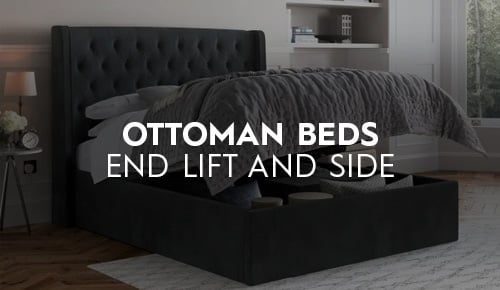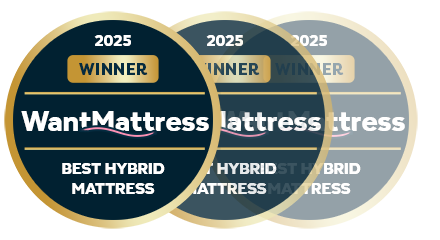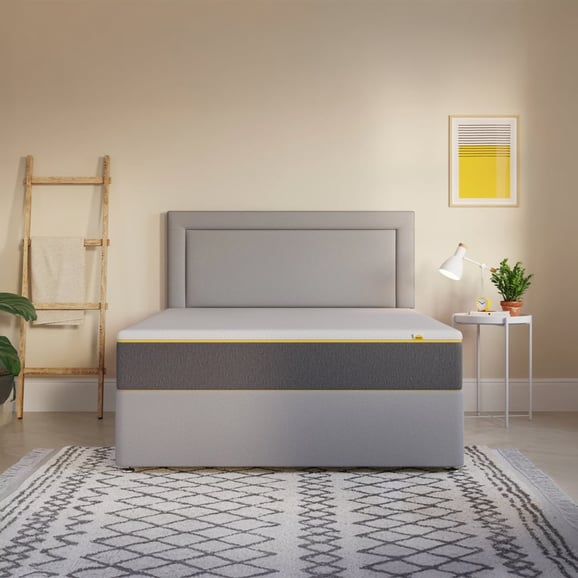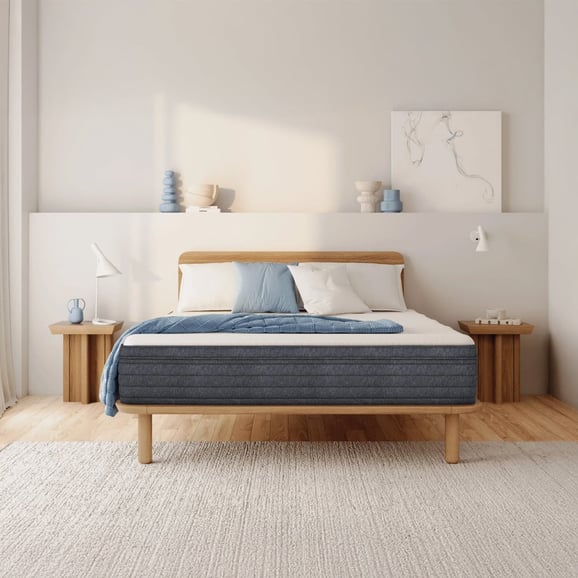Ever tossed and turned, trying to find that perfect sleeping position? For side sleepers, the quest for a good night’s sleep begins with choosing the right mattress. It’s not just about comfort; it’s about support and alignment, ensuring your spine remains in a natural position throughout the night. With an array of options out there, from memory foam to hybrid mattresses, pinpointing the one that cradles your body just right can feel like navigating a minefield. But fret not—understanding the essentials of mattress firmness, materials, and support will transform this daunting task into a straightforward decision. Let’s dive into how you can select the ideal mattress to complement your side-sleeping habits and wake up refreshed every morning.
Key Takeaways
When choosing a mattress for side sleeping, understanding the different types such as memory foam, latex, and gel is crucial for finding the right balance of support and comfort.
Optimal firmness for side sleepers typically falls into the medium-soft to medium range, addressing pressure points effectively without sacrificing spinal alignment.
It’s important to select a comfort grade that caters to your body’s needs, considering how materials like memory foam can offer tailored support for side sleepers.
Firmness levels should be matched not just to your sleeping position but also to your body build; side sleepers with a heavier build might find a medium firmness more supportive.
The choice between a medium and a soft mattress hinges on personal preference and physical requirements, with medium mattresses often providing a good blend of support and comfort for side sleepers.
Our testing approach highlights the importance of considering additional factors such as temperature regulation and motion isolation, ensuring a restful night’s sleep for side sleepers.
Understanding Mattress Types Pocket Sprung Pocket sprung mattresses offer unique benefits for side sleepers. They consist of individual springs encased in their own fabric pockets. This design allows for targeted support where it’s needed most.
These mattresses adapt well to the shape of your body. They provide a firm foundation that supports the spine’s natural curve. Side sleepers often find this feature beneficial as it helps alleviate pressure points.
However, they might not offer the same level of contouring as other types. This can be a drawback for some side sleepers who need more cushioning around the shoulders and hips.
Memory Foam memory foam
Memory foam mattresses are renowned for their contouring properties . They respond to body heat and pressure, moulding to the sleeper’s shape. This creates a personalised sleeping surface.
For side sleepers, memory foam can offer unrivalled comfort. It cradles the body, supporting areas like the waist and relieving pressure on the shoulders and hips.
One potential downside is heat retention. Some individuals may find memory foam too warm. However, newer models come with cooling technologies to mitigate this issue.
Hybrid hybrid mattress
Hybrid mattresses combine the best of both worlds: support and comfort . They typically feature a pocket sprung core with layers of memory foam or latex on top.
This combination is ideal for side sleepers. The springs provide targeted support, while the foam layers add a plush comfort layer that contours to the body.
Hybrids are versatile, catering to various preferences and weights. They’re particularly recommended for side sleepers seeking a balance between firmness and softness.
Latex latex Latex mattresses boast durability and natural materials. Made from rubber tree sap, these mattresses are eco-friendly options.
They provide a responsive sleeping surface that offers support without sinking too deeply. For side sleepers, latex can be a great choice due to its ability to relieve pressure points while maintaining spinal alignment.
Latex is also naturally hypoallergenic and breathable, making it suitable for allergy sufferers and those who tend to overheat at night.
Optimal Firmness for Side Sleepers Firmness Levels Finding the right mattress firmness is crucial for side sleepers. This group often benefits from medium-soft to medium-firm options. These mattresses provide the necessary balance between support and cushioning.
Medium-soft mattresses are ideal for those who weigh less. They allow the body to sink just enough, promoting proper spinal alignment. However, they may not offer sufficient support for heavier individuals.
Medium-firm mattresses cater to a broader weight range. They ensure that the spine remains aligned while also preventing excessive sinking. This firmness level is often recommended for optimal sleep quality .
Choosing between these two largely depends on personal comfort and body weight. It’s essential to consider both factors when selecting a mattress firmness.
Spinal Alignment The importance of spinal alignment cannot be overstated for side sleepers. A misaligned spine can lead to discomfort and long-term health issues. Mattress firmness plays a pivotal role in maintaining this alignment.
Medium-soft mattresses can offer adequate contouring around the shoulders and hips. This feature is vital for side sleepers as it helps distribute body weight evenly, reducing pressure points.
On the other hand, medium-firm mattresses provide a solid foundation that supports the whole body. They prevent deep sinking, which could misalign the spine, especially in the lumbar region.
Ultimately, the goal is to find a mattress that keeps your spine in a natural, straight line from neck to tailbone. Achieving this balance is key to enhancing sleep quality and overall wellbeing.
Personal Preference Personal preference should never be overlooked when choosing mattress firmness. What feels comfortable for one person might not suit another. It’s about finding what works best for you.
e side sleepers prefer a softer feel that cradles their body closely, offering a sense of comfort and warmth. Others might find more support in firmer options, which help them feel lifted rather than enveloped.
It’s advisable to test different mattresses before making a decision. Many companies offer trial periods, allowing you to experience how your body responds to various firmness levels over several nights.
Remember, your comfort is paramount in achieving restful sleep. Don’t compromise on what feels right for your body.
Weight Consideration Body weight significantly influences mattress firmness choice for side sleepers. Heavier individuals generally require more support to avoid sinking too deeply into the mattress surface.
For those over 230 pounds (approx 104 kg), a medium-firm mattress might provide better support while still offering some level of softness needed for side sleeping positions.
Lighter individuals, weighing under 130 pounds (approx 59 kg), may find medium-soft mattresses more comfortable as they provide sufficient give without compromising on support.
Choosing based on weight ensures that you receive adequate pressure relief and spinal alignment, critical factors in avoiding discomfort or pain during sleep.
Balance Between Support and Comfort Achieving a perfect balance between support and comfort is essential for side sleepers to avoid pressure points and ensure high-quality rest.
A good mattress should relieve pressure from key areas such as shoulders and hips while supporting the waist and lower back.
This balance prevents feelings of soreness or numbness upon waking up, contributing significantly to overall sleep quality .
Consider mattresses with memory foam or hybrid constructions as they tend to offer an excellent mix of softness for comfort and firmness for support tailored specifically towards side sleeping preferences.
Addressing Pressure Points pressure points
Deep Comfort A deep comfort layer is crucial for side sleepers. It cushions the hips and shoulders , which bear most of the weight in this position. This layer provides necessary pressure relief and helps maintain a neutral spinal alignment, reducing the risk of waking up with aches.
Mattresses with inadequate support can lead to discomfort around these critical areas. Side sleepers should look for mattresses that offer a plush top layer without compromising on underlying support. Memory foam is often lauded for its ability to contour to the body’s shape, offering exceptional relief at pressure points.
However, not all memory foam mattresses are created equal. The density and thickness of the foam play a significant role in how well it performs. A thicker, higher-density foam will generally offer better support and durability over time.
Mattress Types Different mattress types distribute weight in unique ways to relieve pressure points. Innerspring mattresses, with their coil-based structure, provide a firmer support that can be beneficial for some side sleepers. However, they may not offer the same level of pressure relief as memory foam or latex mattresses.
Memory foam mattresses excel in distributing weight evenly across the surface, minimizing pressure on the hips and shoulders. Their contouring properties allow for spinal alignment and reduce the chances of developing pain points.
Latex mattresses are similar to memory foam in terms of pressure relief but tend to be more responsive. This means they bounce back quicker when you move, which can be helpful for those who change positions frequently during the night.
Hybrid mattresses combine elements from both innerspring and foam designs to offer a balanced feel. They often feature zoned support systems that provide extra firmness where needed, such as under the hips and softer cushioning at the shoulders.
Firmness and Numbness The right mattress firmness can prevent arm numbness and lower back strain — common issues for side sleepers. Too soft a mattress may cause the body to sink too deeply, misaligning the spine and putting undue pressure on the arm beneath your body.
Conversely, a mattress that’s too firm might not accommodate the natural curve of your body, leading to pressure build-up at sensitive points like hips and shoulders. Finding a balance is key; medium-firm mattresses often provide both comfort and support necessary for side sleeping without causing numbness or strain.
Zoned Support Mattresses with zoned support are designed to offer targeted pressure relief at different parts of the body. These mattresses have varying levels of firmness across specific zones — softer under shoulders and firmer under hips — aligning closely with the needs of side sleepers .
Zoned support systems address multiple needs: they cushion sensitive areas while supporting regions that require more stability. This tailored approach ensures that side sleepers can enjoy both comfort and proper alignment throughout the night.
Selecting Comfort Grade Comfort Grades Selecting the right comfort grade is crucial for side sleepers. It significantly impacts sleep quality by addressing pressure points and ensuring a restful night. Comfort grades range from medium-soft to medium-firm , each serving different needs.
Medium-soft mattresses provide a plush feel, conforming closely to the body. This grade is often a great choice for lighter individuals or those seeking extra cushioning at pressure points.
Medium mattresses balance support and softness. They adapt well to various body types, making them a versatile option for couples with different sleeping preferences.
Medium-firm mattresses offer enhanced support, ideal for heavier individuals or those needing more spinal alignment. They help distribute weight evenly, reducing the risk of sinking too deeply.
Sleep Quality The relationship between comfort grades and sleep quality cannot be overstated. A suitable comfort layer can transform sleep experiences, especially for side sleepers vulnerable to pressure build-ups in their shoulders and hips.
A medium-soft mattress might reduce tossing and turning by cushioning these critical areas. However, too soft a mattress could lead to misalignment and subsequent discomfort.
Conversely, a medium-firm mattress could offer superior support but may not provide enough give for optimal pressure relief. Finding the right balance through personal trial is key.
Home trials or in-store testing are highly recommended. They allow individuals to experience different comfort levels firsthand, ensuring an informed choice that matches personal preference and physical requirement.
Mattress Materials The material composition of a mattress plays a significant role in determining its comfort grade. Memory foam, latex, innerspring, and hybrid models each come with distinct characteristics influencing overall comfort and support.
Memory foam excels in contouring around the body, offering exceptional pressure relief—a good housekeeping seal of approval for side sleepers seeking gentle support on their joints.
Latex mattresses are responsive and breathable, providing a firmer feel than memory foam without compromising on comfort. They’re a great choice for those preferring a cooler sleeping surface alongside pressure point alleviation.
Innerspring mattresses traditionally offer firmer support due to their coil construction. However, models with pocketed coils can offer more targeted support and less motion transfer—beneficial features for side sleepers sharing the bed.
Hybrid mattresses combine materials to harness their benefits—foam layers for pressure relief atop springs for bounce and airflow. This combination makes hybrids an excellent all-rounder option catering to various preferences within the medium-soft to medium-firm spectrum.
Memory Foam, Latex, and Gel Roles latex vs memory foam Memory Foam Memory foam stands out for its pressure relief capabilities. It contours closely to the body, providing support where it’s needed most. This makes it an ideal choice for side sleepers who often face pressure points at their hips and shoulders.
The material’s density ensures that it responds slowly to pressure, allowing for a deep cradle that aligns the spine. However, traditional memory foam can retain heat. This might be a concern for those who tend to sleep hot.
Memory foam mattresses are available in various models. Some incorporate a coil system for added support and airflow. These hybrid designs combine the best of both worlds, offering contouring comfort with a bit more bounce.
Latex Latex offers a responsive sleep surface that doesn’t conform as closely as memory foam. This can be beneficial for side sleepers looking for a balance between support and cushioning without feeling “stuck” in their mattress.
Natural latex is also known for its cooling properties. It naturally dissipates heat, providing a cooler sleeping environment than traditional memory foam. For side sleepers who run hot but still want contouring support, latex could be the perfect solution.
Durability is another strong suit of latex mattresses. They tend to last longer than memory foam options, making them a wise investment over time. Natural latex is hypoallergenic, resisting dust mites and mould – an essential consideration for allergy sufferers.
gel vs spring Gel-Infused Memory Foam Gel-infused memory foam addresses one of the main drawbacks of traditional memory foam: heat retention. By incorporating gel particles or layers within the foam, these mattresses significantly improve temperature regulation .
This technology helps to draw heat away from the body, maintaining a comfortable sleeping temperature throughout the night. For side sleepers who appreciate memory foam’s contouring but need a cooler surface, gel-infused options offer an excellent compromise.
The benefits extend beyond just cooling. Gel-infused memory foam also tends to rebound more quickly than its traditional counterpart. This can make moving around on the bed easier while still enjoying the pressure-relieving benefits crucial for side sleeping comfort.
In comparing durability and hypoallergenic properties between latex and memory foam (including gel-infused types), it’s clear each has its advantages. Latex generally offers better longevity and is inherently hypoallergenic – important factors for many shoppers.
However, gel-infused memory foam provides superior temperature control while still offering significant pressure relief – a must-have feature for many side sleepers concerned about overheating during the night.
Firmness Levels Explained Scale Understanding The firmness level of a mattress is crucial for side sleepers. It ranges from soft to firm, often measured on a scale from 1 to 10. Side sleepers generally find comfort in the middle range, typically between 4 and 6. This range provides the necessary cushioning for shoulders and hips, critical pressure points for those who sleep on their side.
Choosing the right firmness is not just about comfort; it also affects the mattress’s longevity. A too-soft mattress might sag prematurely, while an overly firm one could resist conforming to the body’s natural curves, leading to discomfort over time. Therefore, understanding this scale helps in selecting a mattress that balances comfort with durability.
Firmness levels directly impact how a mattress performs over its lifespan. For instance, mattresses with medium firmness tend to maintain their shape and supportive qualities longer than very soft or very hard mattresses. This is because they distribute weight evenly and resist excessive wear on any single point.
Personal Optimum Determining your personal optimal firmness level involves considering several factors beyond just sleeping position. Weight plays a significant role; heavier individuals may sink more into a soft mattress, necessitating a firmer option for adequate support. Conversely, lighter sleepers might find firmer mattresses too harsh and uncomfortable.
Trial periods offered by many manufacturers are invaluable in this process. They allow you to experience sleeping on a mattress for an extended period, which is essential for assessing its true comfort and support levels. Remember, what feels comfortable for a few minutes in a showroom might not hold up through an entire night’s rest.
Listening to your body is key during this trial phase. Pay attention to signs of discomfort or pain upon waking up as indicators that the firmness level might not be suitable for you. Adjustments based on these observations can lead you to discover the perfect balance of comfort and support.
Common Misconceptions A common misconception is equating mattress firmness with support; however, these are distinct characteristics. Support refers to how well a mattress keeps your spine aligned while sleeping, whereas firmness describes the feel of the mattress under your body.
A soft mattress can still offer excellent support if it properly aligns the spine without creating pressure points. Likewise, a firm mattress may not provide adequate support if it fails to accommodate the natural curvature of your body while you sleep on your side.
Understanding this distinction is crucial when searching for the best mattress for side sleeping. It highlights why thorough testing and consideration of individual needs are essential parts of finding a suitable mattress.
Considering Your Build body weight differences
Body Weight Understanding how body weight influences mattress choice is crucial. Heavier individuals often need firmer mattresses. This prevents the mattress from sagging under their weight.
A softer mattress might not offer enough support for those over 230 pounds. This can lead to discomfort and poor sleep quality. The right firmness level keeps the spine aligned, promoting better sleep.
Lighter individuals might find comfort in softer mattresses. These provide ample cushioning without feeling too firm. It’s all about finding a balance that suits your body weight.
Shape Influence Your body shape plays a significant role in selecting the ideal mattress. Different builds require different levels of support to maintain spinal alignment .
People with broader shoulders or hips might prefer a softer mattress. This allows for better contouring around these areas. It ensures the spine remains straight throughout the night.
Conversely, those with a more uniform body shape could opt for medium firmness. This offers an even distribution of support across the body. Ensuring your mattress matches your shape enhances comfort and supports healthful sleep.
Expert Advice Consulting with sleep experts can significantly impact your choice. They can offer tailored advice based on your specific needs.
Online guides also provide valuable insights into choosing the best mattress for side sleepers of different builds. They consider factors like weight, shape, and personal preferences.
e retailers offer sleep trials, allowing you to test mattresses at home. This can be a great way to find your perfect match without guesswork.
Medium vs Soft Mattresses Medium Firmness Medium firm mattresses strike a balance between support and comfort for side sleepers. They provide enough cushioning to relieve pressure on the shoulders and hips, which is crucial for those who favour this sleeping position.
A medium firm bed can cater to sleepers of average weight, offering the necessary support without being too hard. This level of firmness helps maintain spinal alignment, reducing the risk of waking up with aches or pains. Memory foam pillows complement medium mattresses well by adapting to the shape of the head and neck, enhancing overall sleep quality.
Moreover, pocket sprung options within this category offer an added advantage. They respond individually to movement, ensuring that one side of the bed’s activity doesn’t disturb the other sleeper. This feature is particularly beneficial for those sharing a bed.
Soft Mattresses t mattresses provide a plush feel that many sleepers find inviting at first touch. However, for side sleepers, especially those with a lighter build, they might not offer adequate support throughout the night.
The excessive cushioning can lead to misalignment of the spine as the hips and shoulders sink too deeply into the mattress. This misalignment can result in discomfort or pain over time, highlighting why soft beds may not be ideal for everyone.
Yet, some side sleepers still prefer the enveloping comfort of a softer mattress. For them, pairing their bed with firmer memory foam pillows might mitigate potential alignment issues by providing extra support where it’s needed most.
Personal Trial Finding the best mattress for side sleeping isn’t one-size-fits-all; it requires personal trial and error. Sleep trials have become a popular way to test mattresses in your own home over an extended period.
During these trials, pay attention to how your body responds to different levels of firmness. Notice whether you wake up feeling refreshed or if there are signs of strain on your body. Remember that what works for someone else may not suit you perfectly due to differences in body type and personal preference.
Additional Considerations pillos or toppers?
Pillow Choice Choosing the right pillow is as crucial as selecting the perfect mattress for side sleepers. It ensures proper alignment of the neck and spine, reducing potential discomfort. Side sleepers should look for a pillow with enough height to fill the gap between their head and the mattress without tilting their head upwards or downwards.
A supportive pillow can alleviate pressure on the neck and shoulders. Options vary from memory foam to feather-filled, each offering different levels of support and comfort. Personal preference plays a significant role here, as what works for one might not suit another.
Consideration of materials is also vital. Some fabrics offer better breathability than others, which can affect sleep quality, especially for those who tend to get warm at night. A full review of options will help identify a pillow that complements your mattress choice effectively.
Mattress Toppers Mattress toppers offer an additional layer of comfort and support, making them a valuable addition for side sleepers. They are particularly useful for adjusting the firmness level of an existing mattress without the need for a complete replacement.
The right topper can address problems associated with older mattresses, such as uneven surfaces or diminished support over time. Materials range from memory foam to latex, each providing unique benefits like enhanced contouring or increased resilience.
For couples with differing comfort preferences, a mattress topper can be a practical solution. It allows both partners to achieve their desired firmness level without compromising on personal choice or comfort.
Warranty and Trials The significance of warranty and sleep trial periods cannot be overstated when purchasing a new mattress. These features offer peace of mind and safeguard against potential issues down the line.
A lengthy warranty covers defects in materials and workmanship, ensuring that your investment is protected for years to come. It reflects the manufacturer’s confidence in their product’s durability.
Sleep trial periods allow you to test the mattress in your own home over an extended time. This real-world experience is invaluable in determining whether a mattress truly meets your needs before making a final commitment.
Bed Base Compatibility Compatibility with your bed base is another crucial factor in choosing a suitable mattress for side sleeping . The right base enhances the supportive base and longevity of your mattress by ensuring even weight distribution and adequate air circulation.
Traditional box springs may not offer sufficient support for modern mattresses designed with foam layers or hybrid constructions. An incompatible base can lead to premature sagging or uneven wear over time.
Investigating options such as platform beds or adjustable bases might provide better support tailored to your specific mattress type. Such bases accommodate various weights and materials, ensuring optimal performance throughout the lifespan of your mattress.
Our Testing Approach Criteria Selection Our team meticulously selects criteria to evaluate mattresses for side sleepers . We focus on firmness, support, and pressure relief. These elements are crucial for a restful night’s sleep.
We understand that firmness plays a pivotal role in comfort for side sleepers. It must be just right to ensure proper spinal alignment. Our testers assess this by spending numerous nights on each mattress.
Support is another vital aspect. It prevents the body from sinking too deeply into the mattress. We examine how well each model maintains an even surface for the sleeper.
Pressure relief is essential to alleviate stress on shoulders and hips. Our experts use pressure mapping technology to identify models that distribute weight evenly.
User Feedback Gathering user feedback is a cornerstone of our approach. We involve consumer testers in our process to obtain real-world insights.
Consumer testers share their experiences after using the mattress for an extended period. They report on comfort, support, and any changes in sleep quality.
Expert opinions complement these findings. Experts analyse technical aspects like motion isolation and durability of each model.
This combination of user feedback and expert analysis ensures a comprehensive evaluation.
Real-World Testing Real-world testing over extended periods distinguishes our methodology. It reveals how mattresses perform over time, not just upon first use.
Testers note any shifts in firmness or support after months of usage. This long-term perspective is invaluable for assessing durability and lasting comfort.
Motion isolation is another critical factor tested during this phase. Testers evaluate how well the mattress minimises disturbance from a partner’s movements.
Such thorough testing helps us identify models that offer sustained quality and comfort for side sleepers.
Continuous Review Our review process doesn’t stop after initial recommendations are made. We continually revisit our top scores based on new feedback and emerging models.
The continuous review process ensures our advice remains relevant and trustworthy. As brands release new models, we test them against our established criteria.
Updates to our recommendations reflect the latest advancements and user experiences. This guarantees that readers always receive up-to-date information on the best mattresses for side sleepers.
Closing Thoughts Choosing the right mattress for side sleeping isn’t just about comfort; it’s about supporting your body where it needs it most. We’ve walked you through understanding mattress types, pinpointing the optimal firmness, and addressing crucial pressure points to ensure you wake up refreshed, not sore. Memory foam, latex, and gel options each offer unique benefits, but the right choice depends on your personal needs and build. Whether you’re leaning towards a medium or soft mattress, our testing approach aims to guide you towards making an informed decision that aligns with your sleeping habits.
Don’t let another night pass tossing and turning. Take action today by assessing your sleep preferences and considering our expert recommendations. Your perfect mattress is out there waiting to transform your sleep—and by extension, your health and well-being. Ready to make a change? Start exploring your options now.
Frequently Asked Questions What is the best type of mattress for side sleepers? Memory foam and latex mattresses are ideal for side sleepers, offering the right balance of support and pressure relief for hips and shoulders.
How firm should a mattress be for someone who sleeps on their side? A medium-soft to medium firmness level is optimal for side sleepers, providing necessary support while cushioning pressure points.
Why is addressing pressure points important for side sleepers? Addressing pressure points prevents discomfort and pain by ensuring even distribution of weight and reducing stress on hips and shoulders.
What role do memory foam, latex, and gel play in a mattress for side sleepers? These materials contour to the body’s shape, providing tailored support and comfort while helping to regulate temperature throughout the night.
How does one’s build affect the choice of mattress firmness? Your build influences how much support you need; heavier individuals may require a firmer mattress to prevent sinking too deeply.
What are the benefits of choosing a medium over a soft mattress for side sleeping? Medium mattresses offer a better balance of support and comfort, preventing excessive sinkage while still cushioning the body’s natural curves.
Are there any additional considerations when choosing a mattress for side sleeping? Consider breathable materials to maintain a comfortable temperature, and look for mattresses that offer trial periods to ensure personal comfort.














